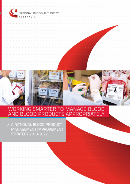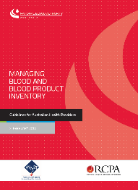Inventory management encompasses all of the activities associated with ordering, storing, handling and issuing of blood products. Good inventory management is necessary to ensure appropriate use of a precious resource. Not holding enough product can potentially put patients at risk or disrupt routine services. However, having too much inventory can deplete products held by the supplier to insufficient levels, increase the age of blood at transfusion and increase wastage.
The National Stewardship Statement outlines that Health Ministers expect health service providers to play an important role in ensuring the safe and efficient receipt, storage and transport of blood and blood products; and that measures are taken to minimise wastage. The statement also recommends that health services have an ordering and receipting verification process (such as BloodNet) in order to provide adequate financial accountability as required by governments. These processes are also required by healthcare organisations under the National Safety and Quality Health Service (NSQHS) Standard 7 – Blood Management.
Health service providers, the National Blood Authority (NBA) and manufacturers in the blood supply chain play a key role in understanding where blood and blood products are being held. This total picture of national inventory of blood and blood products is important to ensure that products are held in the most appropriate place to ensure they can be provided to health services to meet clinical need. BloodNet is a system that allows health service providers to enter their inventory levels, and assists in building up the picture of national inventory. The Australian Red Cross Lifeblood (Lifeblood) produces a National Inventory Template which reports the levels of fresh blood products held at Lifeblood and health service organisations. This is distributed to health service providers who receive blood and blood products. In addition, there is reporting on inventory available through BloodNet such as the Fresh Blood Management, National Health Provider Inventory Level, and various discard and transfer reports.
What is the NBA doing to support improvements in inventory management?
 National Blood Product Management Improvement Strategy 2018-2024
National Blood Product Management Improvement Strategy 2018-2024
 National Inventory Management Framework (NIMF)
National Inventory Management Framework (NIMF)
 Managing Blood and Blood Product Inventory Guidelines for Australian Health Providers
Managing Blood and Blood Product Inventory Guidelines for Australian Health Providers
 Module 1: Managing Blood and Blood Product Transfers
Module 1: Managing Blood and Blood Product Transfers
 Module 2: Managing Intravenous and Subcutaneous Immunoglobulin Inventory
Module 2: Managing Intravenous and Subcutaneous Immunoglobulin Inventory
 10 Tips to Help Manage your Blood Product Inventory
10 Tips to Help Manage your Blood Product Inventory
![]() Blood Product Management Resource Guide (2.8 MB)
Blood Product Management Resource Guide (2.8 MB)
![]() National Blood and Blood Product Wastage Reduction Strategy 2013-17
National Blood and Blood Product Wastage Reduction Strategy 2013-17
Note: This strategy has been superseded by the National Blood Product Management Improvement Strategy 2018-2022
IVIg Governance Review Project on in-hospital management of intravenous immunoglobulin including in-hospital inventory management
Investigatory study on in-hospital management of other plasma derived and recombinant products including inventory management.



